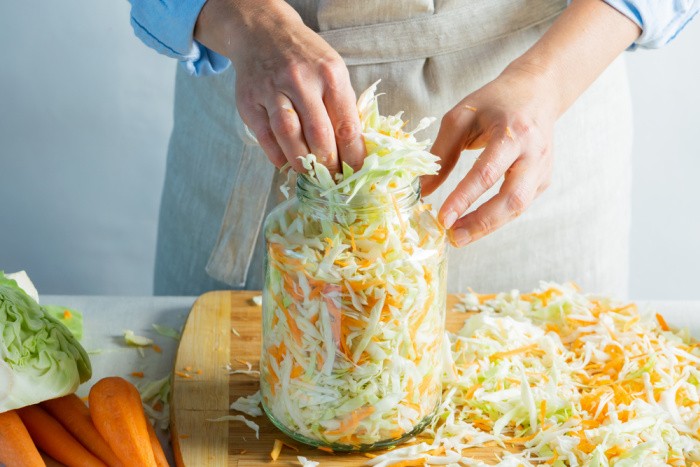
Whether you realize it or not, sauerkraut is a superfood that is good for you! As preppers, we stockpile a lot of canned and processed foods. However, eating processed foods long-term isn’t a good source of vitamins and nutrients that our body needs. That’s why I think it’s a great idea to stock sauerkraut, as well as other superfoods. Printable recipe below; enjoy.

Things You May Need
- Cutting Board
- Quart Mason Jars
- Crock
- Knife
What is Sauerkraut?
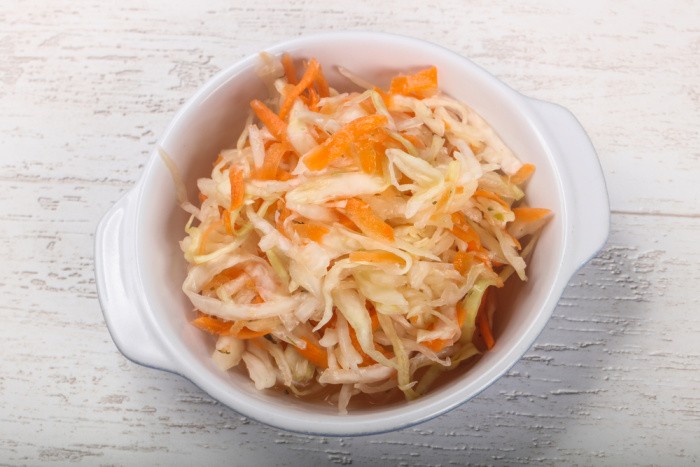
Sauerkraut is a type of fermented cabbage. We believe it originated in China more than 2,000 years ago. Fermentation was a popular way of keeping foods from spoiling quickly. It’s a popular side dish and condiment in many cultures. And, due to its fermentation process, sauerkraut offers a variety of nutrition and health benefits that a regular head of cabbage can’t give.
Stock Sauerkraut for the Health Benefits
Our grandparents stored sauerkraut because it is easily stored for up to 2-years without refrigeration and has a variety of health benefits. I DO NOT recommend storing it without refrigeration for safety reasons. I store mine in the refrigerator. When you eat only canned and processed foods, you need something that restores your gut health. Sauerkraut is loaded with nutrients, including probiotics and enzymes, that help you get more nutrients out of every meal. Here are some of the health benefits of sauerkraut:
It Contains a Variety of Nutrients
During fermentation, microorganisms digest the cabbage’s natural sugars and convert them into carbon dioxide and organic acids. Thus, making sauerkraut super nutritious. One cup of it contains the following:
- Calories: 27
- Fat: 0 grams
- Carbs: 6 grams
- Fiber: 4 grams
- Protein: 1 gram
- Sodium: 41% of the Daily Value (DV)
- Vitamin C: 23% of the DV
- Vitamin K1: 15% of the DV
- Iron: 12% of the DV
- Manganese: 9% of the DV
- Vitamin B6: 11% of the DV
- Folate: 9% of the DV
- Copper: 15% of the DV
- Potassium: 5% of the DV
Sauerkraut is a Good Probiotic
Your gut contains over 100 trillion microorganisms. They are called “gut flora.” Unpasteurized sauerkraut contains probiotics, or good bacteria, that act as a first line of defense against toxins and harmful bacteria. You get more probiotics in 1 gram of sauerkraut than you do in a probiotic supplement.
It Could Aid in Weight Regulation
Sauerkraut is high in fiber and low in calories. High-fiber diets keep you feeling more full for a more extended period. Thus, eating this superfood may help prevent unwanted weight gain from processed foods high in calories and sugar.
May Reduce the Risk of Cancer
Sauerkraut is packed full of antioxidants. These antioxidants, like others, may help reduce DNA damage, prevent cell mutations, and block excessive cell growth that could lead to tumors. You can read about it here.
Reduces Cholesterol Levels
Having high cholesterol can negatively affect your heart. Because sauerkraut is packed with probiotics and fiber, it helps to lower cholesterol levels. Additionally, it contains vitamin K2, which is believed to help reduce the risk of heart disease.
Promotes Bone Health
In addition to reducing the risk of heart disease, vitamin K2 activates two proteins that bind to calcium. Calcium is the main mineral found in bones. Thus, sauerkraut also helps to build stronger, healthier bones.
Is Store-Bought Sauerkraut Just as Good for You as Homemade?
The simple answer is NO! Most commercially canned sauerkraut has been pasteurized. High heat is used in this process which kills both good and bad bacteria to ensure the sauerkraut is shelf-stable. This means it kills off the good bacteria that give you many health benefits. If you do purchase store-bought sauerkraut, make sure to keep the following in mind:
- Avoid pasteurized sauerkraut. It is typically pasteurized if it is off the shelf, killing the beneficial probiotics.
- Stay away from preservatives. Store-bought varieties typically contain preservatives that lower the probiotic count.
- Make sure there are no added sugars. To reap the benefits, sauerkraut should only contain two ingredients: cabbage and salt.
How to Make Sauerkraut
If you want to reap the benefits of sauerkraut, you can make it yourself right at home! It is one of the simplest things to make! Here’s how:
Ingredients for Option One
You only need 3-ingredients to make sauerkraut:
- Hallowed out a head of cabbage
- Iodized Salt
- A container of Brine (salt water) that can be sealed with a lid
Directions for Option One
Follow these simple directions to make your sauerkraut that you can store for up to 4-6 months in your refrigerator:
- Hollow out a head of cabbage. Cut the stem and core out, then carefully cut on angles and spoon to hollow out the cabbage.
- Pour salt into the cabbage. You will fill the hollowed-out section with salt.
- Fill a container with brine. This container must be big enough to hold your cabbage, and the brine must fully cover the head of the cabbage.
- Cover and seal. Place your cabbage into the brine and seal it with a lid.
Ingredients for Option Two
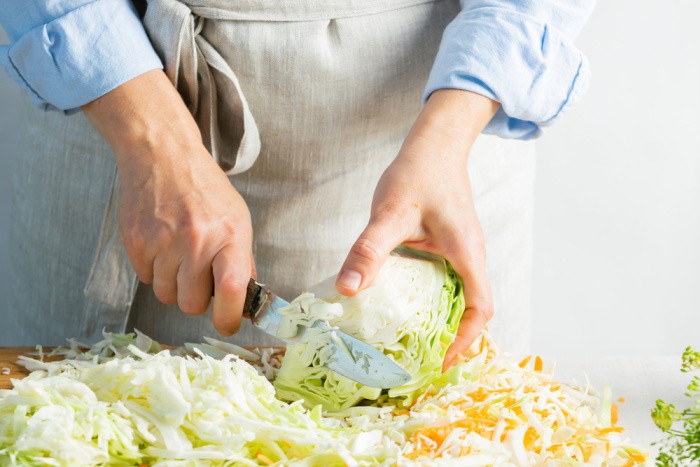
You only need 4-ingredients to make my sauerkraut:
- Shredded cabbage
- Shredded carrots
- Sea Salt
- Water
Directions for Option Two (this is how I make it)
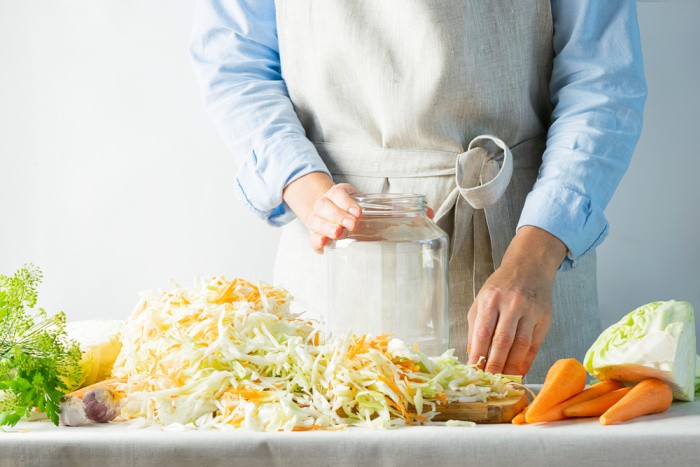
Follow these simple directions to make your sauerkraut that you can store for up to 4-6 months in your refrigerator.
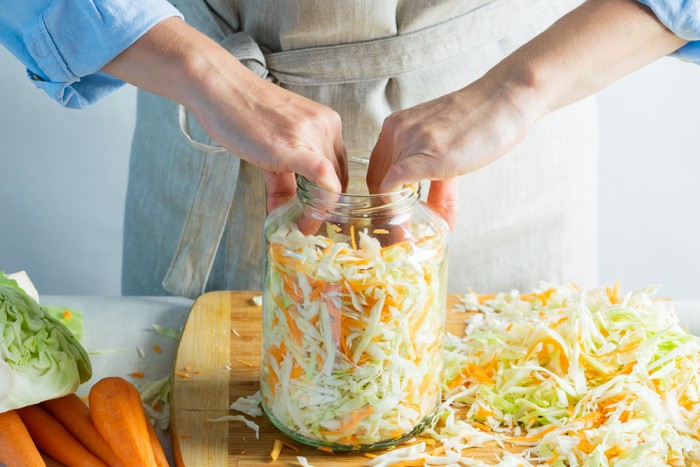
- Shred the cabbage thinly.
- Shred the carrots thinly.
- Add the cabbage and carrots to an airtight jar.
- Sprinkle sea salt on top of the cabbage and carrots in the jar. Redmond Sea Salt is my favorite.
- Cover the mixture with brine water.
- Keep pushing the contents down so they don’t dry out, and add more brine if needed.
Linda’s Sauerkraut Recipe

Sauerkraut Made with Cabbage & Carrots
Ingredients
- Shredded Cabbage
- Shredded Carrots
- 1-1/2 tablespoons Sea Salt (per quart of cabbage)
- Add brine as needed to cover the cabbage and carrots. For me, the basic ratio of salt to water for a BRINE is 4 tablespoons of salt per quart (4 cups)
Instructions
Brine Mixture
-
For me, the basic ratio of salt to water for a BRINE is 4 tablespoons of salt per quart (4 cups)
How to Make the SauerKraut
-
Keep pushing the contents down so it does not dry out, add more brine if needed. Place in the refrigerator for up to 4-6 months.
-
Shred the cabbage thinly. Shred the carrots thinly. Add the cabbage and carrots to an airtight jar.
-
Sprinkle sea salt on top of the cabbage and carrots in the jar. Redmond Sea Salt is my favorite.
-
Cover the mixture with brine water mixture.
-
Keep pushing the contents down so it does not dry out, add more brine if needed. Place in the refrigerator for up 4-6 months.
How to Stock Sauerkraut
You do want to store your sauerkraut properly so it doesn’t go bad. Due to its acidic nature, it can survive at room temperature for quite some time. While it can survive at room temperature, keeping it in colder temperatures is best to slow down the fermentation process. During storage, you want to avoid temperature fluctuations and keep it under a constant temperature. I highly recommend storing it in the refrigerator. Better safe than sorry is my motto.
How to Tell if It Has Gone Bad
Unfortunately, sauerkraut can go bad! You don’t want to eat it if it has gone bad. Here are a few signs that it has gone bad and you shouldn’t eat it:
- Off-smelling aroma.
- Weird texture or color.
- Greenish-blue specs are on it.
Why You Should Stock Sauerkraut
Final Word
Storing foods high in vitamins and nutrients is crucial to survival. Not getting adequate nutrition, over time, makes us malnourished even if we eat daily. When we stock sauerkraut, we can use this superfood to balance our nutritional needs. There are other superfoods you can store if you don’t like sauerkraut, such as pomegranate, berries, and garlic. Stock what you typically eat, but also stock things to keep you healthy and well-nourished. May God Bless this world, Linda
Copyright Images: Sauerkraut Deposit photos_300775952_s-2019, Sauerkraut Deposit photos_300775754_s-2019, Sauerkraut Deposit photos_308479066_s-2019, Sauerkraut Deposit photos_308478900_s-2019, Sauerkraut Deposit photos_142166930_s-2019
The post Why You Should Stock Sauerkraut appeared first on Food Storage Moms.
from Food Storage Moms
No comments:
Post a Comment